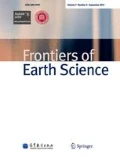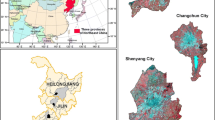Abstract
Urbanization is an irreversible trend worldwide, especially in rapidly developing China. Accelerated urbanization has resulted in rapid urban sprawl and urban landscape pattern changes. Quantifying the spatiotemporal dynamics of urban land use and landscape pattern not only can reveal the characteristics of social transfer and economic development, but also can provide insights into the driving mechanisms of land use changes. In this study, we integrated remote sensing (RS), geographic information system (GIS), landscape metrics, and gradient analysis to quantitatively compare the spatiotemporal dynamics of land use, urban sprawl, and landscape pattern for nine cities in the Pearl River Delta from 1985‒2000. For the whole study region, urbanization was obvious. The results show an increase in urban buildup land and shrinkage of cropland in the Pearl River Delta. However, the nine cities differed greatly in terms of the process and magnitude of urban sprawl for both the spatial and temporal dimensions. This was most evident for the cities of Guangzhou and Shenzhen. Gradient analysis on urban landscape changes could deepen understanding of the stages of urban development and provide a scientific foundation for future urban planning and land management strategies in China.
Similar content being viewed by others
References
Angel S, Parent J, Civco D L, Blei A, Potere D (2011). The dimensions of global urban expansion: estimates and projections for all countries, 2000–2050. Prog Plann, 75(2): 53–107
Chen M X, Liu W D, Tao X L (2013). Evolution and assessment on China’s urbanization 1960-2010: under-urbanization or over-urbanization? Habitat Int, 38: 25–33
Deng J S, Wang K, Hong Y, Qi J G (2009). Spatio-temporal dynamics and evolution of land use change and landscape pattern in response to rapid urbanization. Landsc Urban Plan, 92(3-4): 187–198
Ding C R (2003). Land policy reform in China: assessment and prospects. Land Use Policy, 20(2): 109–120
Du S Q, Shi P J, Van Rompaey A (2014). The relationship between urban sprawl and farmland displacement in the Pearl River Delta, China. Land (Basel), 3(1): 34–51
Fan F L, Fan W (2014). Understanding spatial-temporal urban expansion pattern (1990-2009) using impervious surface data and landscape indexes: a case study in Guangzhou (China). J Appl Remote Sens, 8(1): 083609
Fichera C R, Modica G, Pollino M (2012). Land cover classification and change-detection analysis using multi-temporal remote sensed imagery and landscape metrics. Eur J Remote Sens, 45: 1–18
Grimm N B, Faeth S H, Golubiewski N E, Redman C L, Wu J G, Bai X M, Briggs J M (2008). Global change and the ecology of cities. Science, 319(5864): 756–760
Haas J, Ban Y F (2014). Urban growth and environmental impacts in Jing-Jin-Ji, the Yangtze, River Delta and the Pearl River Delta. Int J Appl Earth Obs Geoinf, 30: 42–55
Hammer R B, Stewart S I, Winkler R L, Radeloff V C, Voss P R (2004). Characterizing dynamic spatial and temporal residential density patterns from 1940?1990 across the North Central United States. Landsc Urban Plan, 69(2-3): 183–199
Han L J, Zhou W Q, Li W F (2015). Increasing impact of urban fine particles (PM2.5) on areas surrounding Chinese cities. Sci Rep, 5: 12467
Irwin E G, Bockstael N E (2007). The evolution of urban sprawl: evidence of spatial heterogeneity and increasing land fragmentation. Proc Natl Acad Sci USA, 104(52): 20672–20677
Ji W, Ma J, Twibell R W, Underhill K (2006). Characterizing urban sprawl using multi-stage remote sensing images and landscape metrics. Comput Environ Urban Syst, 30(6): 861–879
Johnson M P (2001). Environmental impacts of urban sprawl: a survey of the literature and proposed research agenda. Environ Plann A, 33(4): 717–735
Li J X, Li C, Zhu F G, Song C H, Wu J G (2013). Spatiotemporal pattern of urbanization in Shanghai, China between 1989 and 2005. Landsc Ecol, 28(8): 1545–1565
Lin G (2006). Emphases and difficulties in planning of town groups in the Pearl River Delta. Planners, 22(3): 19–21
Lin G C S (2001). Metropolitan development in a transitional socialist economy: spatial restructuring in the Pearl River Delta, China. Urban Stud, 38(3): 383–406
Liu H, Weng Q H (2013). Landscape metrics for analysing urbanizationinduced land use and land cover changes. Geocarto Int, 28(7): 582–593
Liu J Y, Kuang W H, Zhang Z X, Xu X L, Qin Y W, Ning J, Zhou W C, Zhang SW, Li R D, Yan C Z, Wu S X, Shi X Z, Jiang N, Yu D S, Pan X Z, Chi W F (2014). Spatiotemporal characteristics, patterns, and causes of land-use changes in China since the late 1980s. J Geogr Sci, 24(2): 195–210
Liu J Y, Liu M L, Zhuang D F, Zhang Z X, Deng X Z (2003). Study on spatial pattern of land-use change in China during 1995–2000. Sci China Earth Sci, 46(4): 373–384
Liu J, Zhan J Y, Deng X Z (2005). Spatio-temporal patterns and driving forces of urban land expansion in China during the economic reform era. Ambio, 34(6): 450–455
Long H L, Liu Y S, Wu X Q, Dong G H (2009). Spatio-temporal dynamic patterns of farmland and rural settlements in Su-Xi-Chang region: implications for building a new countryside in coastal China. Land Use Policy, 26(2): 322–333
Luck M, Wu J G (2002). A gradient analysis of urban landscape pattern: a case study from the Phoenix metropolitan region, Arizona, USA. Landsc Ecol, 17(4): 327–339
Lv Z Q, Dai F Q, Sun C (2012). Evaluation of urban sprawl and urban landscape pattern in a rapidly developing region. Environ Monit Assess, 184(10): 6437–6448
McDonnell M J, Hahs A K (2008). The use of gradient analysis studies in advancing our understanding of the ecology of urbanizing landscapes: current status and future directions. Landsc Ecol, 23(10): 1143–1155
McGarigal K, Cushman S, Neel M, Ene E (2002). FRAGSTATS v3: spatial pattern analysis program for categorical maps. Retrieved July 2016, from http://www.umass.edu/landeco/research/fragstats/fragstats.html
McGarigal K, Marks B J (1995). FRAGSTATS: spatial pattern analysis program for quantifying landscape structure. Retrieved July 2016, from http://www.umass.edu/landeco/pubs/mcgarigal.marks.1995.pdf
National Bureau of Statistics of China (2016). Statistical communique of the people’s republic of China on the 2015 national economic and social development. Retrieved July 2016, from http://www.stats.gov.cn/english/PressRelease/201602/t20160229_1324019.html
O’Neill R V, Krummel J R, Gardner R H, Sugihara G, Jackson B, De Angelis D L, Milne B T, Turner M G, Zygmunt B, Christensen S W, Dale V H, Graham R L (1988). Indices of landscape pattern. Landsc Ecol, 1(3): 153–162
Qin J, Fang C L, Wang Y, Li G D, Wang S J (2015). Evaluation of threedimensional urban expansion: a case study of Yangzhou City, Jiangsu Province, China. Chin Geogr Sci, 25(2): 224–236
Ramachandra T V, Bharath A H, Sowmyashree M V (2015). Monitoring urbanization and its implications in a mega city from space: spatiotemporal patterns and its indicators. J Environ Manage, 148: 67–81
Sato Y, Yamamoto K (2005). Population concentration, urbanization, and demographic transition. J Urban Econ, 58(1): 45–61
Schwarz N (2010). Urban form revisited—Selecting indicators for characterising European cities. Landsc Urban Plan, 96(1): 29–47
Seto K C, Fragkias M (2005). Quantifying spatiotemporal patterns of urban land-use change in four cities of China with time series landscape metrics. Landsc Ecol, 20(7): 871–888
Seto K C, Fragkias M, Güneralp B, Reilly M K (2011). A meta-analysis of global urban land expansion. PLoS One, 6(8): e23777
Seto K C, Güneralp B, Hutyra L R (2012). Global forecasts of urban expansion to 2030 and direct impacts on biodiversity and carbon pools. Proc Natl Acad Sci USA, 109(40): 16083–16088
Seto K C, Kaufmann R K (2003). Modeling the drivers of urban land use change in the Pearl River Delta, China: integrating remote sensing with socioeconomic data. Land Econ, 79(1): 106–121
Shi P J, Chen J, Pan Y Z (2000). Land use change mechanism in Shenzhen city. Acta Geogr Sin, 55(2): 151–160
Statistics Bureau of Guangdong Province (2014). Guangdong Statistical Yearbook 2013. Beijing: China Statistics Press
The Pearl River Delta Region Planning (2014). Retrieved October 2016, from http://www.gdupi.com/prd2014/productshow.asp?id=102
Tian G J, Wu J G, Yang Z F (2010). Spatial pattern of urban functions in the Beijing metropolitan region. Habitat Int, 34(2): 249–255
United Nations (2014). World urbanization prospects: the 2014 revision, Highlights. (ST/ESA/SER.A/352). Retrieved July 2016, from http://www.urbangateway.org/system/files/documents/urbangateway/wup2014-highlights.pdf
Wang Y P, Wang Y L, Wu J S (2009). Urbanization and informal development in China: urban villages in Shenzhen. Int J Urban Reg Res, 33(4): 957–973
Wu J G (2004). Effects of changing scale on landscape pattern analysis: scaling relations. Landsc Ecol, 19(2): 125–138
Wu W J, Zhao S Q, Zhu C, Jiang J L (2015). A comparative study of urban expansion in Beijing, Tianjin and Shijiazhuang over the past three decades. Landsc Urban Plan, 134: 93–106
Xiao J Y, Shen Y J, Ge J F, Tateishi R, Tang C Y, Liang Y Q, Huang Z Y (2006). Evaluating urban expansion and land use change in Shijiazhuang, China, by using GIS and remote sensing. Landsc Urban Plan, 75(1-2): 69–80
Xu J Y, Zhang Z X, Zhao X L, Liu B, Yi L (2015). Spatial-temporal characteristics and driving forces of urban sprawl for major cities of the Pearl River Delta region in recent 40 years. Acta Scientiarum Naturalium Univerisitatis Pekinensis, 51(6): 1119–1131
Xu X L, Min X B (2013). Quantifying spatiotemporal patterns of urban expansion in China using remote sensing data. Cities, 35: 104–113
Xu X Q, Li X (2009). Research on the urbanization of Pearl River Delta (1978-2008): review and preview. Human Geogr, 24(1): 1–6
Yang X J (2013). China’s rapid urbanization. Science, 342(6156): 310
Yeh A G O, Li X (1999). Economic development and agricultural land loss in the Pearl River Delta, China. Habitat Int, 23(3): 373–390
Yu X J, Ng C N (2007). Spatial and temporal dynamics of urban sprawl along two urban–rural transects: a case study of Guangzhou, China. Landsc Urban Plan, 79(1): 96–109
Zhang T (2000). Land market forces and government’s role in sprawl: the case of China. Cities, 17(2): 123–135
Acknowledgments
This research was supported by the National Key Basic Research Program of China (No. 2015CB452702), the National Natural Science Foundation of China (Grant Nos. 41571098, 41530749, and 41371196), Key Programs of the Chinese Academy of Sciences (ZDRW-ZS- 2016-6-4) and A Major Consulting Project of Strategic Development Institute, Chinese Academy of Sciences (No. Y02015003). There is no conflict of interest in this manuscript. We gratefully acknowledge the anonymous reviewers for spending their valuable time and providing constructive comments and suggestions on this manuscript.
Author information
Authors and Affiliations
Corresponding author
Additional information
Erfu Dai received the Ph.D. degree in geography from Peking University, China in 2002. He is currently a Professor of Key Laboratory of Land Surface Pattern and Simulation, Institute of Geographic Sciences and Natural Resources Research, Chinese Academy of Sciences. His research interests include comprehensive study of physical geography, climate change and regional response, and LUCC (Land Use/Cover Change) modelling. His recent research projects have been funded by National Basic Research Program of China (973 Program), National Natural Science Foundation of China and National Key Technology R&D Program. Prof. Dai is the Member of IGU/ LUCC commission, Member of AAG (Association of American Geographers), Member of the Geographical Society of China, and Member of China Society of Natural Resources. He won the tenth National Youth Science and Technology Award for Geography. E-mail: daief@igsnrr.ac.cn
Zhuo Wu received the M. S. degree in geography from Capital Normal University, China in 2014. He is currently a Ph.D. candidate in Key Laboratory of Land Surface Pattern and Simulation, Institute of Geographic Sciences and Natural Resources Research, Chinese Academy of Sciences, and University of Chinese Academy of Sciences. His research interests focus on land use and ecological process response. E-mail: wuz.14b@igsnrr.ac.cn
Xiaodian Du received the M. S. degree in geography from Capital Normal University, China in 2011. Her research interests include land use change and landscape pattern research. E-mail: duxiaodian_china@163.com
Rights and permissions
About this article
Cite this article
Dai, E., Wu, Z. & Du, X. A gradient analysis on urban sprawl and urban landscape pattern between 1985 and 2000 in the Pearl River Delta, China. Front. Earth Sci. 12, 791–807 (2018). https://doi.org/10.1007/s11707-017-0637-0
Received:
Accepted:
Published:
Issue Date:
DOI: https://doi.org/10.1007/s11707-017-0637-0




